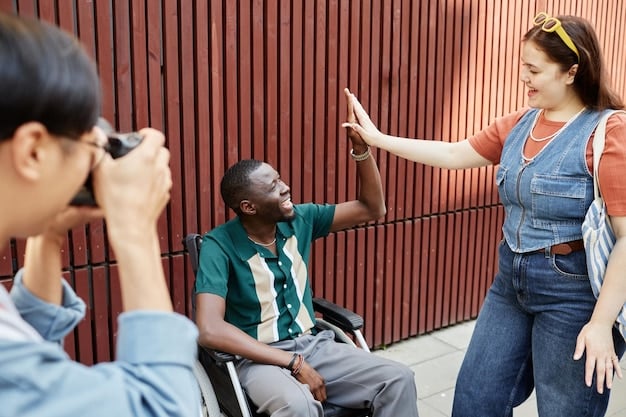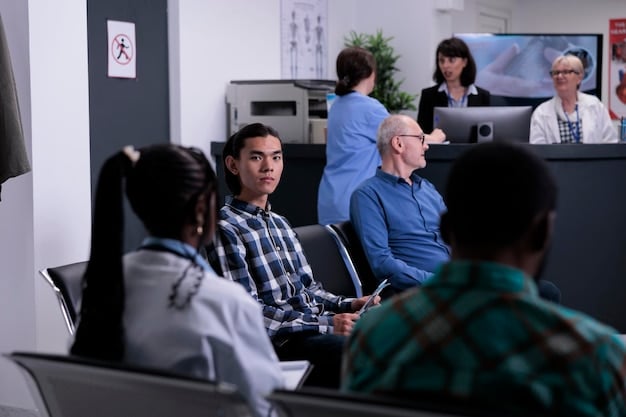Cultural Event Organizers: 2025 Accessibility Guidelines Prep Guide

Advertisements
Navigating the updated accessibility guidelines for cultural event organizers in 2025 is crucial for ensuring inclusive experiences and avoiding potential legal liabilities; proactive preparation is key to successful compliance.
As the cultural landscape continues to evolve, a significant shift is on the horizon for event organizers. Cultural Event Organizers: Are You Prepared for the Updated Accessibility Guidelines in 2025? This question is not merely rhetorical but represents a critical call to action, urging a thorough assessment of current practices against impending regulatory changes. Ensuring inclusivity is no longer an optional add-on but a fundamental requirement, shaping how we design, execute, and experience cultural events.
The Imperative of Accessibility in Cultural Events
The concept of accessibility in cultural events extends far beyond mere compliance; it embodies the spirit of inclusion and equity. Every individual, regardless of their physical abilities, sensory perceptions, or cognitive functions, deserves the opportunity to participate fully in the rich tapestry of cultural experiences. This fundamental principle drives the updates to accessibility guidelines, aiming to dismantle barriers that have historically excluded significant portions of our population.
For too long, accessibility has been an afterthought, a retrofit rather than an integral component of event planning. However, legal precedents and societal expectations are rapidly changing. Organizations that neglect these aspects risk not only reputational damage and potential lawsuits but also alienate a valuable segment of their audience and potential talent pool. The year 2025 marks a pivotal moment, demanding a proactive and comprehensive understanding of these new standards.
Understanding the Spirit of the Law
It’s important to view regulatory updates not as a burden but as a framework for fostering genuinely inclusive environments. The upcoming guidelines are designed to provide clearer parameters and stronger enforcement mechanisms, ensuring that accessibility is woven into the very fabric of event design and delivery. This holistic approach ensures that accessibility isn’t about ticking boxes but about creating truly welcoming spaces.
- Universal Design Principles: Emphasizes creating environments and products usable by all people, to the greatest extent possible, without the need for adaptation or specialized design.
- Equitable Access: Ensures that all attendees have equivalent opportunities to participate, rather than simply offering minimal accommodations.
- Legal and Ethical Obligations: Highlights that accessibility is both a legal requirement and an ethical imperative for cultural institutions.
Cultural event organizers face the unique challenge of balancing artistic vision with practical access requirements. This requires innovative thinking and a willingness to adapt traditional methods. From the initial conceptualization of an event to its final execution, accessibility must be a guiding principle, ensuring that no one is left behind. This commitment enhances the overall experience for everyone and elevates the cultural sector as a whole.
The conversation around updated guidelines isn’t new; it’s a culmination of years of advocacy and evolving understanding of diverse needs. The 2025 deadline reflects a greater emphasis on proactive planning and a shift from reactive problem-solving to preventative design. Embracing this shift will position cultural organizations as leaders in fostering truly inclusive communities. Ignoring these changes, however, could lead to significant setbacks, underscoring the urgency of immediate preparation.
Key Changes and Updates Expected in 2025 Guidelines
The updated accessibility guidelines for 2025 are expected to introduce several crucial changes, focusing on more comprehensive and enforceable standards. While specific details may vary, the general direction points towards stricter adherence to universal design principles, enhanced digital accessibility requirements, and broader definitions of what constitutes an accessible experience. Cultural event organizers must delve into these specifics to ensure full compliance and avoid last-minute scrambling.
One primary area of focus is likely to be physical accessibility, expanding beyond basic ramp installations to encompass more nuanced aspects such as adequate maneuvering space, accessible seating arrangements, and clear pathways. This means reviewing venue layouts, emergency evacuation procedures, and even how stage areas are configured. The goal is to eliminate physical barriers that often prevent individuals with mobility impairments from fully engaging with events.
Digital Accessibility: A Growing Frontier
In an increasingly digital world, the accessibility of online platforms is paramount. The 2025 guidelines are anticipated to place significant emphasis on digital accessibility, covering aspects like accessible websites, ticketing systems, virtual event platforms, and promotional materials. This includes compliance with standards like WCAG (Web Content Accessibility Guidelines) at a higher conformance level.
- Website Compliance: Ensuring event websites and online ticketing systems are navigable via screen readers, keyboard-only navigation, and possess sufficient color contrast.
- Virtual Event Platforms: Requiring captions, sign language interpretation, and accessible interactive features for online attendees.
- Digital Marketing Materials: Making sure all digital flyers, social media graphics, and videos are accessible with alternative text for images and transcripts for audio.
Moreover, the guidelines are likely to address sensory accessibility, including provisions for individuals with vision or hearing impairments. This could involve mandatory audio descriptions for visual presentations, tactile exhibits, assistive listening devices, and ASL (American Sign Language) interpretation for live performances. These measures aim to provide equivalent experiences for all sensory profiles, enriching the event for a wider audience.
Cognitive accessibility, though often overlooked, is also gaining prominence. Event organizers may need to consider “plain language” materials, quiet spaces, and support for individuals with cognitive and intellectual disabilities. This ensures that information is easy to understand and that sensory overload can be mitigated, creating a more inclusive and less overwhelming environment for everyone. Preparing for these multifaceted changes requires a holistic approach and a commitment to continuous improvement.
Proactive Strategies for Compliance and Inclusion
Successfully navigating the updated accessibility guidelines requires a proactive and strategic approach, moving beyond mere compliance to genuine inclusion. Cultural event organizers should initiate comprehensive audits of their current practices well in advance of 2025, identifying potential gaps and developing actionable plans. This holistic view encompasses physical spaces, digital assets, communication strategies, and staff training.
One fundamental strategy is to embed accessibility considerations into every stage of event planning, from initial concept development to post-event evaluation. This “design from the outset” philosophy is far more efficient and effective than attempting to retrofit accessibility features later. Engaging with disability advocacy groups and individuals with diverse needs early in the planning process can provide invaluable insights and prevent costly oversights.
Assessing Your Current Accessibility Landscape
A thorough self-assessment is the cornerstone of effective preparation. This involves evaluating your physical venues, reviewing digital platforms, scrutinizing communication channels, and auditing staff knowledge. Identifying strengths and weaknesses provides a clear roadmap for improvements.
- Venue Audits: Walk through your space with a critical eye, considering pathways, entrances, restrooms, and seating from an accessibility perspective.
- Digital Review: Use accessibility checkers and user testing to identify issues on your website, ticketing portals, and social media.
- Policy and Communication Audit: Examine existing accessibility policies, emergency plans, and how information is conveyed to diverse audiences.
Investing in comprehensive staff training is another critical component. All personnel, from front-of-house staff to security teams and volunteers, should receive training on disability awareness, inclusive communication, and specific accessibility protocols. This training should emphasize empathy and practical tips for assisting attendees with various needs, fostering a culture of genuine support and understanding.
Financial planning for accessibility improvements is equally important. Organizations should allocate dedicated budgets for necessary renovations, digital upgrades, and assistive technologies. Seeking grants or partnerships focused on accessibility can also support these endeavors. Proactive budgeting avoids last-minute financial strain and ensures that accessibility initiatives are adequately resourced, demonstrating a true commitment to inclusivity rather than a reactive scramble.

Leveraging Technology for Enhanced Accessibility
Technology offers powerful solutions for enhancing accessibility at cultural events, enabling organizers to reach wider audiences and provide more inclusive experiences. Beyond basic website compliance, innovative tech tools can bridge gaps in communication, navigation, and engagement. Embracing these advancements is not just about meeting guidelines but about enriching the experience for every attendee, regardless of their abilities.
Consider the integration of digital tools that can assist attendees with sensory impairments. For example, augmented reality (AR) applications could provide visual overlays with sign language interpretation or detailed audio descriptions of exhibits. Similarly, smart navigation apps could guide individuals with visual impairments through venues using haptic feedback or audio cues, greatly enhancing their independence and enjoyment.
Innovative Tech Solutions to Consider
The landscape of accessibility technology is constantly evolving, presenting new opportunities for cultural event organizers to innovate and elevate their offerings. Investing in user-friendly and reliable tech can transform how diverse audiences interact with your events.
- Assistive Listening Systems: Modern systems that connect directly to smartphones via an app, providing clear audio feeds in various languages or with enhanced clarity.
- Real-time Captioning (CART): Beyond pre-recorded captions, CART services offer live captioning for spontaneous speeches and discussions, crucial for conferences and panels.
- Braille and Tactile Maps: Integrating digital Braille displays with interactive maps for venue navigation, offering a dynamic alternative to static print.
- AI-Powered Translation: Utilizing AI for instantaneous translation of spoken words or text into multiple languages, including sign languages via avatars, expanding reach.
Virtual and augmented reality (VR/AR) also hold immense potential. While a full VR experience of an event might challenge traditional concepts, AR could be used to provide accessible information points, translate signage in real-time, or even offer personalized audio commentary. The key lies in selecting technologies that genuinely enhance accessibility and are intuitive for users.
Furthermore, event apps can be designed with accessibility at their core, allowing for customizable text sizes, color contrasts, voice navigation, and integration with screen readers. Such apps could also provide real-time updates on accessible amenities, quiet zones, and accessible transportation options. By thoughtfully integrating technology, cultural event organizers can transform potential barriers into opportunities for enriched, universally accessible experiences, staying ahead of merely meeting the 2025 guidelines.
Training Staff and Volunteers for Inclusive Practices
Even the most meticulously planned accessible event can fall short if staff and volunteers are not adequately trained. Human interaction is a critical component of the attendee experience, and poorly informed or insensitive interactions can quickly undermine efforts towards inclusivity. Comprehensive training programs are therefore essential for ensuring that every member of your team is equipped to provide respectful, effective, and welcoming assistance to all attendees.
Training should go beyond mere awareness and delve into practical, actionable steps. It should cover not only the literal meaning of accessibility guidelines but also the underlying philosophy of inclusion and empathy. This includes understanding different types of disabilities, appropriate etiquette, and how to respond to various accessibility needs without making assumptions or causing discomfort. Role-playing scenarios can be particularly effective in preparing staff for real-world interactions.
Key Training Modules for Your Team
Developing a robust training curriculum ensures consistency and effectiveness. These modules should be mandatory for all personnel involved in event operations, fostering a culture of proactive support.
- Disability Etiquette and Awareness: Core principles of interacting respectfully with individuals with various disabilities, avoiding stereotypes and offensive language.
- Accessible Communication: Training on clear verbal communication, offering assistance appropriately, and understanding basic sign language or assistive listening devices.
- Emergency Procedures: Specific protocols for assisting individuals with disabilities during emergencies, including evacuation plans and designated assistance points.
- Navigating Accessible Features: Familiarization with all accessible routes, restrooms, quiet areas, and how to operate any assistive technology available at the venue.
- Problem-Solving and Responsiveness: Empowering staff to identify potential barriers and quickly address accessibility needs on the spot or escalate appropriately.
Empowering staff to be proactive in offering assistance, rather than waiting to be asked, can significantly improve the experience for attendees with disabilities. This approach demonstrates a commitment to hospitality and inclusion. Training should emphasize that accessibility is everyone’s responsibility, not just a designated few. Regular refreshers and ongoing education are also crucial to keep staff updated on best practices and evolving needs.
Furthermore, involving individuals with disabilities in the training process, either as trainers or guest speakers, can provide invaluable firsthand perspectives. Their insights can help staff understand the real-world implications of accessibility barriers and the impact of truly inclusive interactions. By fostering a well-trained and empathetic team, cultural event organizers can ensure that their commitment to accessibility is felt in every interaction, building trust and loyalty among diverse audiences.
Budgeting and Resource Allocation for Accessibility
Implementing comprehensive accessibility initiatives requires careful financial planning and strategic resource allocation. Cultural event organizers must move beyond viewing accessibility as an optional expense and integrate it as a core component of their operational budget. Proactive budgeting prevents costly last-minute fixes and ensures that efforts are sustainable and effective in the long run, meeting the 2025 guidelines without financial strain.
Begin by conducting a detailed accessibility audit that includes an estimated cost for each recommended improvement. This audit should categorize expenses into one-time capital investments (e.g., permanent ramps, accessible restrooms), recurring operational costs (e.g., sign language interpreters, assistive listening device maintenance), and ongoing training expenses. Having a clear financial roadmap is crucial for securing necessary funds.
Funding Opportunities and Best Practices
Exploring various funding avenues and adopting smart financial practices can help offset the costs associated with accessibility enhancements. Partnerships and grants often play a significant role in making these initiatives viable.
- Dedicated Budget Line Item: Establish a specific budget line for accessibility within your overall event or organizational budget, ensuring it’s not an afterthought.
- Grant Applications: Research local, state, and federal grants available for disability inclusion, cultural programming, or facility improvements. Many foundations also offer specific grants for accessibility.
- Corporate Sponsorships: Seek out corporate partners who prioritize diversity, equity, and inclusion (DEI) as part of their CSR (Corporate Social Responsibility) initiatives.
- Community Partnerships: Collaborate with local disability organizations; they may offer volunteer support, expertise, or even shared resources, reducing direct costs.
- Long-Term Investment Mindset: View accessibility improvements as long-term investments that enhance attendee experience, broaden audience reach, and mitigate legal risks.
Prioritizing improvements based on impact and feasibility is also key. Some changes might be relatively inexpensive but have a significant positive impact, while others may require substantial investment over time. Breaking down larger projects into manageable phases can make them more achievable financially. For instance, focusing first on accessible communication and digital platforms, then moving to physical renovations.

Exploring shared resources or collaborative initiatives with other cultural organizations in your community can also be a cost-effective approach. Pooled resources could fund specialized equipment, shared training programs, or joint hiring of accessibility consultants. By being strategic and proactive in budgeting, cultural event organizers can ensure that accessibility is not just a regulatory hurdle but a transformative investment that benefits everyone, demonstrating true preparation for 2025 and beyond.
Future-Proofing Your Cultural Events Beyond 2025
While the 2025 guidelines serve as a critical benchmark, true leadership in cultural event organization involves future-proofing your operations to anticipate evolving accessibility needs and societal expectations. This means adopting a flexible, adaptable mindset, continuously seeking feedback, and embracing innovation that goes beyond minimum compliance. The goal is to create truly inclusive ecosystems that evolve with the diverse needs of your audience.
Future-proofing involves staying abreast of emerging technologies and best practices in accessibility. This might include researching advancements in AI-driven assistive technologies, exploring immersive experiences designed with universal access in mind, or adopting personalized accessibility profiles for repeat attendees. It’s about moving from a “one-size-fits-all” approach to one that acknowledges and accommodates individual preferences and needs.
Building a Culture of Continuous Improvement
Accessibility is not a destination but an ongoing journey. Establishing mechanisms for continuous feedback and improvement ensures that your efforts remain relevant and effective.
- Regular Accessibility Audits: Conduct periodic internal or external audits to identify new barriers or areas for improvement as technologies and understanding evolve.
- User Feedback Loops: Create accessible channels for attendees to provide feedback on their experiences, and actively incorporate this feedback into future planning.
- Dedicated Accessibility Committee: Form a cross-functional team within your organization focused solely on accessibility initiatives, review, and implementation.
- Networking and Research: Stay connected with disability advocates, accessibility experts, and other cultural organizations to share best practices and learn from their experiences.
Moreover, advocate for broader systemic changes. Cultural event organizers can play a significant role in influencing policy, promoting universal design in urban planning, and raising public awareness about the importance of accessibility. By becoming champions for inclusion, they contribute to a more accessible society as a whole, extending their impact beyond their immediate events.
The landscape of accessibility will undoubtedly continue to evolve, driven by technological advancements, demographic shifts, and greater understanding of human diversity. By embedding a culture of foresight, adaptation, and genuine empathy, cultural event organizers can ensure their events remain vibrant, relevant, and accessible to everyone, for generations to come. This proactive stance not only complies with future mandates but also solidifies their reputation as truly inclusive and forward-thinking cultural institutions.
| Key Area | Brief Description |
|---|---|
| ♿ Proactive Planning | Start early, integrate accessibility from concept to execution. |
| 💻 Digital Compliance | Ensure websites, apps, and online content meet WCAG standards. |
| 🗣️ Staff Training | Train all personnel on disability etiquette and accessible communication. |
| 💰 Resource Allocation | Dedicate budget and explore grants for accessibility improvements. |
Frequently Asked Questions About 2025 Accessibility Guidelines
▼
The 2025 guidelines are expected to bring more comprehensive and enforceable standards, especially focusing on enhanced physical accessibility, stricter digital compliance (like WCAG 2.2), and broader considerations for sensory and cognitive disabilities. Organizers should anticipate detailed requirements for venues, online platforms, and communication methods to ensure a truly inclusive experience for all attendees.
▼
Assessing readiness involves a multi-faceted audit. Begin with a professional physical venue assessment for pathways, restrooms, and emergency exits. Conduct digital accessibility tests on websites and ticketing systems using tools and user feedback. Evaluate communication materials for clarity and alternative formats. Finally, gauge staff awareness and training on disability etiquette and service provision. This comprehensive review highlights areas needing improvement.
▼
Technology is pivotal. It can facilitate digital accessibility via WCAG-compliant websites and apps, integrating features like screen reader compatibility, text-to-speech, and customizable interfaces. For physical events, tech can provide assistive listening devices, real-time captioning, and navigation aids for visually impaired attendees. Leveraging AI for automated translations or AR for visual aids can also significantly enhance the experience, moving beyond basic compliance.
▼
Crucial staff training includes disability etiquette, inclusive communication techniques, and practical guidance on assisting attendees with diverse needs. Topics should cover understanding different disabilities, proper language, how to offer assistance without making assumptions, emergency protocols for individuals with limited mobility, and familiarity with available assistive technologies. Regular refreshers and scenario-based training are highly recommended to ensure preparedness and empathy.
▼
Compliance may require significant financial investment in renovations, digital upgrades, and ongoing services. Organizers should conduct a detailed cost assessment, allocate specific budget lines for accessibility, and explore various funding avenues. This includes applying for grants from government agencies or private foundations, seeking corporate sponsorships focused on DEI initiatives, and considering partnerships with disability advocacy groups to pool resources and expertise, ensuring sustainable implementation.
Conclusion
The impending 2025 accessibility guidelines represent more than just regulatory updates for cultural event organizers; they signify a profound evolution in how we view and execute inclusive experiences. Proactive planning, embracing technological advancements, comprehensive staff training, and strategic resource allocation are not just recommendations but imperative steps toward future-proofing your events. By embedding accessibility into the core of your operations, cultural institutions can champion universal access, enrich the experiences of all attendees, and cultivate a truly welcoming environment that reflects the diverse tapestry of our society, ensuring sustained relevance and positive impact for years to come.





